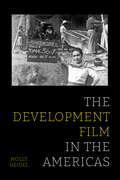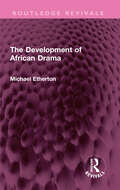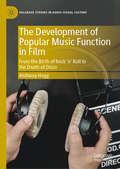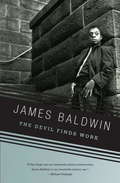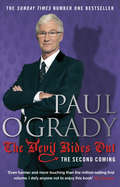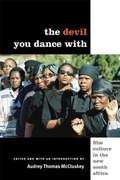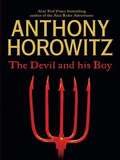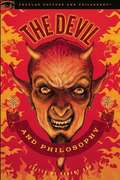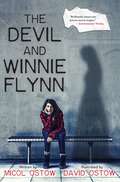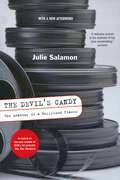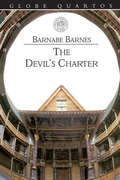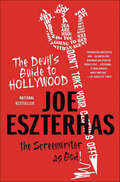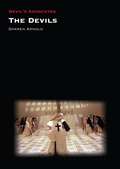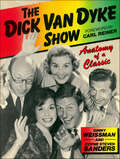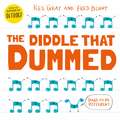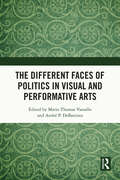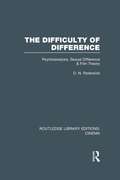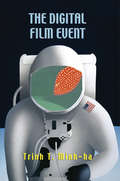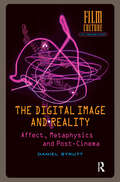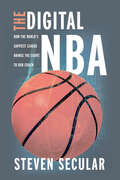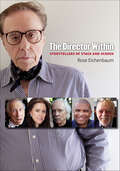- Table View
- List View
The Development Film in the Americas
by Molly GeidelIn this book, Molly Geidel traces the rise and fall of the development film, an overlooked film genre that circulated widely in the Americas from the 1940s through the 1970s. Development films, often short documentaries, were made at the behest of state agencies, global governance organizations, and private corporations to link capitalist conceptions of economic growth to improved quality of life. Development films made this link beautifully compelling, blending elements from ethnography and socially committed leftist film traditions to create indelible narratives of underdevelopment and modernization. The Development Film in the Americas tells the story of these films and the hemispheric cohort of filmmakers who crafted them, chronicling the filmmakers' fraught relationships with both the organizations they worked for and the actors in their films.
The Development of African Drama (Routledge Revivals)
by Michael EthertonOriginally published in 1982, this book explores concepts such as ‘traditional performance’ and African theatre’. It analyses the links between drama and ritual, and drama and music and diagnoses the confusions in our thought. The reader is reminded that drama is never merely the printed word, but that its existence as literature and in performance is necessarily different. The analysis shows that literature tends to replace performance; and drama, removed from the popular domain, becomes elitist. The book’s richness lies in the constantly stimulating analysis of ‘art’ theatre, as exemplified in protest plays, in African adaptations and transpositions of such classical subjects as the Bacchae and Everyman, in plays on African history, on colonialism and neo-colonialism. The final chapters argue that the form of African drama needs to evolve as the content does.
The Development of Popular Music Function in Film: From the Birth of Rock ‘n’ Roll to the Death of Disco (Palgrave Studies in Audio-Visual Culture)
by Anthony HoggThis book offers a unique examination of the development of popular music function in film. It assesses the contribution of popular music to the interpretation of the most significant films, covering the period from rock ‘n’ roll’s initial introduction at the opening of Blackboard Jungle, to the backlash against disco, which followed soon after the release of Saturday Night Fever. By dividing this period into five phases—The Classical American Musical Phase, The British Invasion Phase, The New Hollywood Alienation Phase, The Disco Phase and The Post-Disco Conservative Phase—the book pinpoints key moments at which individual developments occurred and lays out a path of expansion in popular music function. Each chapter offers close analyses of this period’s most innovative films; examines the cultural, historical, technical and industrial factors peculiar to each phase and considers the influence of these upon the specific timing of functional advances.
The Devil Finds Work: An Essay (Vintage International #1)
by James BaldwinFrom "the best essayist in this country&” (The New York Times Book Review) comes an incisive book-length essay about racism in American movies that challenges the underlying assumptions in many of the films that have shaped our consciousness. Baldwin&’s personal reflections on movies gathered here in a book-length essay are also an appraisal of American racial politics. Offering a look at racism in American movies and a vision of America&’s self-delusions and deceptions, Baldwin considers such films as In the Heat of the Night, Guess Who&’s Coming to Dinner, and The Exorcist.Here are our loves and hates, biases and cruelties, fears and ignorance reflected by the films that have entertained and shaped us. And here too is the stunning prose of a writer whose passion never diminished his struggle for equality, justice, and social change.
The Devil Rides Out: Wickedly funny and painfully honest stories from Paul O’Grady
by Paul O'GradyTHE SUNDAY TIMES NUMBER ONE BESTSELLER'Far and away the best writer of the lot . . . his turn of phrase is a joy.' The Sunday TimesBirkenhead, 1973. The eighteen-year-old Paul O'Grady gets ready for a big Saturday night out on the town. New white T-shirt, freshly ironed jeans, looking good. As he bids farewell to his mum, who's on the phone to his auntie, and wanders off down the street in a cloud of aftershave, he hears her familiar cry: 'Oh, the devil rides out tonight, Annie. The devil rides out!'The further adventures of Paul O'Grady - following on from the million-copy-selling At My Mother's Knee - are, if anything, even more hilarious and outrageous than what has come before. To say that The Devil Rides Out is action-packed is an understatement. Its extraordinary cast of characters includes lords and ladies, the legendary Vera, a serial killer, more prostitutes than you can shake a stick at and drag queens of every shape and size. Wickedly funny, often moving, and searingly honest, Paul's tales of the unexpected will make your jaw drop and your hair stand on end. And you'll laugh like a drain. The Devil Rides Out is one hell of a read!Readers love The Devil Rides Out:'At times heart-breaking but . . . incredibly funny.' *****'A powerful story of the man behind the persona . . . the most fabulous and modest tart with a heart of gold.' *****'Very down to earth, heart-breaking at times but Paul always comes back making you laugh.' *****
The Devil You Dance With: Film Culture in the New South Africa
by Audrey MccluskeySouth African film culture, like so much of its public life, has undergone a tremendous transformation during its first decade of democracy. Filmmakers, once in exile, banned, or severely restricted, have returned home; subjects once outlawed by the apparatchiks of apartheid are now fair game; and a new crop of insurgent filmmakers are coming to the fore. Compiled and edited by Audrey Thomas McCluskey, this extraordinary volume presents twenty-five in-depth interviews with established and emerging South African filmmakers such as Zola Maseko, Teboho Mahlatsi, Ntshaveni wa Luruli, and many more. The interviews capture the filmmakers' spirit, energy, and ambition as they attempt to give birth to a film culture that reflects the heart and aspirations of their diverse and emergent nation.
The Devil and His Boy
by Anthony HorowitzThe English Ladder is a four-level course designed to help pupils take their first steps in English. Join the Fantastic family for fun, adventure and lively language learning through engaging stories, challenging songs, games, tongue twisters, and communication activities. This Level 3 Pupil's Book features topic-based units introducing new vocabulary, phonics activities for enjoyable pronunciation practice, a CLIL feature in every unit, focusing on core subjects such as science and maths, and clear grammar targets for each unit.
The Devil and Philosophy
by Robert ArpIn The Devil and Philosophy, 34 philosophers explore questions about one of the most recognizable and influential characters (villains?) of all time. From Roman Polanski's The Ninth Gate to J.R.R. Tolkien's The Silmarillion to Bram Stoker's Dracula to Darth Vader to Al Pacino's iconic performance in The Devil's Advocate, this book demonstrates that a little devil goes a long way. From humorous appearances, as in Kevin Smith's film Dogma and Chuck Palahniuk's novels Damned and its sequel Doomed, to more villanous appearances, such as Gabriel Byrne's cold outing as Satan in End of Days, The Devil in Philosophy proves that the Devil comes in many forms.Through the lenses of Jung, Kant, Kundera, Balkan, Plato, Bradwardine, Aristotle, Hume, Blackburn, Descartes, Lavey, Thoreau, and Aquinas, The Devil and Philosophy take a philosophical look at one of time's greatest characters. Are there any good arguments for the actual existence of the Devil? Does demonic evil thrive in Gotham City? Can humans really be accountable for all evil? Which truths about the Devil are actual facts? Is Milton correct, in that the Devil believes he is doing good?
The Devil and Winnie Flynn
by Micol Ostow"A love letter to all your favorite horror movie classics . . . Micol Ostow's razor sharp writing and David Ostow's wonderful illustrations combine for an unforgettable reading experience."—Courtney Summers, author of This Is Not a Test and All the RageWinnie Flynn doesn&’t believe in ghosts. (Though she wouldn&’t mind a visit from her mom, explaining why she took her own life.) When her mysterious aunt Maggie, a high-profile TV producer, recruits Winnie to spend a summer working as a production assistant on her current reality hit, Fantastic, Fearsome, she suddenly finds herself in the one place her mother would never go: New Jersey.New Jersey&’s famous Devil makes perfect fodder for Maggie&’s show. But as the filming progresses, Winnie sees and hears things that make her think that the Devil might not be totally fake after all. Things that involve her and her family. Things about her mother&’s death that might explain why she&’s never met Aunt Maggie until now.Winnie soon discovers her family&’s history is deeply entwined with the Devil&’s. If she&’s going to make it out of the Pine Barrens alive, she might have to start believing in what her aunt is telling her—and find out what she isn&’t.
The Devil's Candy: The Anatomy Of A Hollywood Fiasco
by Julie Salamon"A definitive portrait of the madness of big-time moviemaking" (Newsweek), now the basis for the new season of TCM's hit podcast, "The Plot Thickens" and featuring a new afterword by the authorWhen Brian De Palma agreed to allow Julie Salamon unlimited access to the film production of Tom Wolfe's best-selling book The Bonfire of the Vanities, both director and journalist must have felt like they were on to something big. How could it lose? But instead Salamon got a front-row seat at the Hollywood disaster of the decade. She shadowed the film from its early stages through the last of the eviscerating reviews, and met everyone from the actors to the technicians to the studio executives. They'd all signed on for a blockbuster, but there was a sense of impending doom from the start--heart-of-gold characters replaced Wolfe's satiric creations; affable Tom Hanks was cast as the patrician heel; Melanie Griffith appeared mid-shoot with new, bigger breasts. With a keen eye and ear, Salamon shows us how the best of intentions turned into a legendary Hollywood debacle.The Devil's Candy joins John Gregory Dunne's The Studio, Steven Bach's Final Cut, and William Goldman's Adventures in the Screen Trade as a classic for anyone interested in the workings of Hollywood. With a new afterword profiling De Palma ten years after the movie's devastating flop (and this book's best-selling publication), Julie Salamon has created a riveting insider's portrait of an industry where art, talent, ego, and money combine and clash on a monumental scale.
The Devil's Charter: A Tragedie, Conteining The Life And Death Of Pope Alexander The Sixt (classic Reprint) (Globe Quartos)
by Barnabe BarnesFirst Published in 1999. Routledge is an imprint of Taylor & Francis, an informa company.
The Devil's Guide to Hollywood: The Screenwriter as God!
by Joe EszterhasIn The Devil's Guide to Hollywood, bestselling author and legendary bad-boy screenwriter Joe Eszterhas tells everything he knows about the industry, its players and screenwriting itself—from the first blank sheet of paper in the Olivetti to the size of the credit on the one-sheet. "There's just one hunk of funny anecdote after another, quotes from everyone who ever mattered in the movie biz, and the thing is jam-packed with screenwriterly advice. Plus it's hilariously funny, ribald, sexy and brilliant."—Liz SmithOften practical and always entertaining, The Devil's Guide to Hollywood distills everything one of Hollywood's most accomplished screenwriters knows about the business, from writing advice to negotiation tricks, from the wisdom of past players to the feuds of current ones. Eszterhas has selected his personal pantheon of the most loved and loathed players in the business and treats the reader to a treasure trove of stories, quotes and wisdom from those luminaries, who include William Goldman (loathes) and Zsa Zsa Gabor (loves). The Devil's Guide to Hollywood could only have been written by someone who loves the business as much as Eszterhas does—but who also has its number."Eszterhas delivers a dishy, catty mix of reminiscences and Hollywood trivia…his forte is skewering sycophants and phonies in this opinionated showcase of the underside of Hollywood life."—Publishers Weekly
The Devils (Devil's Advocates)
by Darren ArnoldUndoubtedly the most notorious title in director Ken Russell’s controversial filmography, The Devils (1973) caused a real furor on its initial theatrical release, only to largely disappear for many years. This Devil’s Advocate considers the film’s historical context, as the timing of the first appearance of The Devils is of particular importance, its authorship and adaptation (Russell’s auteur reputation aside, the screenplay is based on John Whiting’s 1961 play of the same name, which was in turn based on Aldous Huxley’s 1952 book The Devils of Loudun), and its generic hybridity. Darren Arnold goes on to examine the themes prevalent in the film—this is the only film of Russell’s which the director considered to be political—and considers the representation of gender and sexuality, gender fluidity, and how sex and religion clash to interesting and controversial effect. He concludes by revisiting the film’s censorship travails and the various versions of The Devils that have appeared on both big and small screens, and the film’s legacy and influence.
The Dharma of The Princess Bride: What the Coolest Fairy Tale of Our Time Can Teach Us About Buddhism and Relationships
by Ethan NichternAn engagingly contemporary approach to Buddhism—through the lens of an iconic film and its memorable charactersHumorous yet spiritually rigorous in the tradition of Zen and the Art of Motorcycle Maintenance and The Tao of Pooh, drawing from pop culture and from personal experience, The Dharma of “The Princess Bride” teaches us how to understand and navigate our most important personal relationships from a twenty-first-century Buddhist perspective.Friendship. Romance. Family. These are the three areas Ethan Nichtern delves into, taking as departure points the indelible characters from Rob Reiner’s perennially popular film—Westley, Fezzik, Vizzini, Count Rugen, Princess Buttercup, and others—as he also draws lessons from his own life and his work as a meditation teacher. Nichtern devotes the first section of the book to exploring the dynamics of friendship. Why do people become friends? What can we learn from the sufferings of Inigo Montoya and Fezzik? Next, he leads us through all the phases of illusion and disillusion we encounter in our romantic pursuits, providing a healthy dose of lightheartedness along the way by sharing his own Princess Buttercup List and the vicissitudes of his dating life as he ponders how we idealize and objectify romantic love. Finally, Nichtern draws upon the demands of his own family history and the film’s character the Grandson to explore the dynamics of “the last frontier of awakening,” a reference to his teacher Chogyam Trungpa’s claim that it’s possible to be enlightened everywhere except around your family. With The Dharma of “The Princess Bride” in hand, we can set out on the path to contemporary Buddhist enlightenment with the most important relationships in our lives.
The Diary of Anne Frank and Other Plays About Courage
by Katherine RobinsonThe five plays are The Karate Kid by Robert Mark Kemen; Where the Lilies Bloom by Earl Hamner, Jr., based on the book by Vera and Bill Cleaver; Thunder on Sycamore Street by Reginald Rose; The Pride of Jesse Hallam by Suzanne P. Clauser; and The Diary of Anne Frank by Frances Goodrich and Albert Hackett.
The Diary of Jinky: Dog of a Hollywood Wife
by Carole Raphaelle DavisThe diary of a dog, Jinky, is a narrative as if told to Hollywood actress and singer, Carole Raphaelle Davis. Jinky's life began in a cage in San Pedro, California. Some creepy guy bought the dog for his stupid wife who didn't want him. One night, the guy took the dog to the pound and threw him into a cold, wet crate and slammed the gate. Luckily, Jinky was rescued and he now lives in a beautiful house in the Hollywood Hills.
The Dick Van Dyke Show: Anatomy of a Classic
by Ginny Weissman Coyne Steven SandersIn the history of television, there are very few shows that can truly be called "classics." The Dick Van Dyke Show is one of those few--and for the first time, authors Weissman and Sanders have succeed in capturing the unique flavor of this very appealing, warm comedy that went straight to the heart of the American public. An affectionate and nostalgic portrait of a show more than twenty years old that is still in reruns, The Dick Van Dyke Show tells the inside story of the situational comedy whose phenomenal success was a surprise even to its creators.Tracing its evolution from the pilot, Head of the Family starring Carl Reiner, through the ordeal of finding the right actor to play the clumsy but talented TV writer Rob Petrie, gathering the supporting cast that included Rose Marie and Morey Amsterdam, whose presence added a sharp-edged humor to the series, to the discovery of the largely unknown Mary Tyler Moore to play the Capri pants-clad Laura Petrie, The Dick Van Dyke Show plots the day-to-day course of getting and keeping the show on the air. Written with the complete cooperation of every member of the cast, this book takes us through the weekly process of consistently fine writing, rehearsing, improvising, and polishing the show in which the entire company participated. From start to finish, the cast was a tight group whose personal warmth, vitality, and camaraderie created a unique chemistry that shone through every episode.Containing over 100 photos, synopses of all 158 episodes and the complete script of one of them, lists of all the awards garnered by the show and its cast during its five-year run, and an update on where everyone is today, The Dick Van Dyke Show is a loving and carefully researched tribute to one of the most beloved comedy series of all time.
The Diddle That Dummed
by Kes GrayA laugh-out-loud musical story full of hilarious word play and silliness from the author of Oi Frog!, brilliantly illustrated by Fred Blunt.Flinty Bo Diddle is writing a tune for his fiddle. All his diddles have lined up nicely - except for one who keeps going DUM, right in the middle! No matter what he tries he just can't get this diddle to diddle like it's supposed to! A story about standing out from the crowd that will have you in fits of giggles!Kes Gray is the author of the top ten bestselling series Oi Frog and Friends, which has sold 1.4 million copies to date.
The Different Faces of Politics in the Visual and Performative Arts
by Mario Thomas Vassallo André P. DeBattistaThis book highlights the linkages between politics and governance and the arts. The essays in the volume show how visual and performative arts have challenged those in power — or conversely patronised by them — been used for propaganda, stir up national fervour and found themselves at the receiving end of political censure. They focus on the tension and symbiosis between the politician and the artist foregrounding how they have always tried to influence, challenge, and, in some cases, undermine one another. This volume will serve as an indispensable source for researchers and academics in political science, the humanities and performing arts.
The Difficulty of Difference: Psychoanalysis, Sexual Difference and Film Theory (Routledge Library Editions: Cinema)
by D. N. RodowickThis book argues that serious misreadings of Freud and Lacan on sexual difference have characterized prevailing models of psychoanalytic film criticism. In critiquing theories of identification and female spectatorship, the author maintains that early film theorists and feminist critics are equally guilty of imposing a binary conception of sexual difference on Freud’s thought. By embracing such a rigid definition of male/female difference, they fail to understand the fundamentally complex and fluid process of sexual identification as it is articulated in Freud’s writing, constructed in film texts, and negotiated by spectators. The book turns to Freud’s work on fantasy to develop an alternative model for interpreting sexuality in the visual and narrative arts, one that emphasizes a ‘politics of critical reading’ over accepted theories of ideological identification. Originally published in 1991, its strategic focus on psychoanalysis itself as an object of historical and critical inquiry, and not simply as a reading method is the unique quality of this book.
The Digital Banal: New Media and American Literature and Culture (Literature Now)
by Zara DinnenContemporary culture is haunted by its media. Yet in their ubiquity, digital media have become increasingly banal, making it harder for us to register their novelty or the scope of the social changes they have wrought. What do we learn about our media environment when we look closely at the ways novelists and filmmakers narrate and depict banal use of everyday technologies? How do we encounter our own media use in scenes of waiting for e-mail, watching eBay bids, programming as work, and worrying about numbers of social media likes, friends, and followers?Zara Dinnen analyzes a range of prominent contemporary novels, films, and artworks to contend that we live in the condition of the “digital banal,” not noticing the affective and political novelty of our relationship to digital media. Authors like Jennifer Egan, Dave Eggers, Sheila Heti, Jonathan Lethem, Gary Shteyngart, Colson Whitehead, Mark Amerika, Ellen Ullman, and Danica Novgorodoff and films such as The Social Network and Catfish critique and reveal the ways in which digital labor isolates the individual; how the work of programming has become an operation of power; and the continuation of the “Californian ideology,” which has folded the radical into the rote and the imaginary into the mundane. The works of these writers and artists, Dinnen argues, also offer ways of resisting the more troubling aspects of the effects of new technologies, as well as timely methods for seeing the digital banal as a politics of suppression. Bridging the gap between literary studies and media studies, The Digital Banal recovers the shrouded disturbances that can help us recognize and antagonize our media environment.
The Digital Film Event
by Trinh T. Minh-haEndless travel in cyberspace, virtual reality, and the dream of limitless speed: technology changes our sense of self. In her new book, Trinh Minh-ha explores the way technology transforms our perception of reality. "We are all engaged in social rituals in our daily activities, she writes, "and by remaining unaware of their artistic ritual propensity, we remain 'in conformity'." Her goal, as a thinker and an artist, is to transform our understanding of technology and speed so that we are able to "turn an instrument into a creative tool and to step out of the one-dimensional, technologically servile mind." The paradox that "stillness contains speed within it" is central to Trinh's concept of the digital apparatus. With her signature amalgam of feminism, Eastern philosophy, and practical understanding of filmmaking, Trinh Minh-ha presents a much-needed advance in our concept of the real in a technological age.
The Digital Image and Reality: Affect, Metaphysics and Post-Cinema (Film Culture in Transition)
by Daniel StruttThe media technologies that surround and suffuse our everyday life profoundly affect our relation to reality. Philosophers since Plato and Aristotle have sought to understand the complex influence of apparently simple tools of expression on our understanding and experience of the world, time, space, materiality and energy. The Digital Image and Reality takes up this crucial philosophical task for our digital era. This rich yet accessible work argues that when new visual technologies arrive to represent and simulate reality, they give rise to nothing less than a radically different sensual image of the world. Through engaging with post-cinematic content and the new digital formats in which it appears, Strutt uncovers and explores how digital image-making is integral to emergent modes of metaphysical reflection - to speculative futurism, optimistic nihilism, and ethical plasticity. Ultimately, he prompts the reader to ask whether the impact of digital image processes might go even beyond our subjective consciousness of reality, towards the synthesis of objective actuality itself.
The Digital NBA: How the World's Savviest League Brings the Court to Our Couch (Studies in Sports Media)
by Steven SecularThe National Basketball Association reaches a global audience via a multiplatform strategy that leverages its uncanny ability to connect fans to all things NBA. Steven Secular brings readers inside the league’s global operations and traces the history of the NBA’s approach to sports media from its 1980s embrace of cable through the streaming revolution of the twenty-first century. As fans around the world stream games and other league content, NBA teams incorporate foreign languages and cultures into broadcasts to boost their product’s appeal to audiences in Brazil, China, and beyond. Secular’s analysis reveals how the NBA continues to transform itself into a wildly successful media producer and distributor more akin to a streaming studio than the sports leagues of old even as its media partners and sponsors erase any notion of sports as a civic good. A timely look at a dynamic media landscape, The Digital NBA shows how the games we love became content first and sport a distant second.
The Director Within: Storytellers of Stage and Screen
by Rose EichenbaumIn Rose Eichenbaum's latest book on the confluence of art making and human expression, she sits down with thirty-five modern day storytellers—the directors of theater, film, and television. Eichenbaum's subjects speak with revealing clarity about the entertainment industry, the role and life of the director, and how theatrical and cinematic storytelling impacts our culture and our lives. The Director Within includes interviews with Peter Bogdanovich (The Last Picture Show), Julie Taymor (The Lion King), Mel Brooks (Blazing Saddles), Tim Van Patten (The Sopranos, Boardwalk Empire), Hal Prince (The Phantom of the Opera), Barry Levinson (Rain Man), and many others. The interviews are skillfully crafted, sensitively executed, and brimming with honesty and insight. The accompanying portraits demonstrate Eichenbaum's mastery of photography and convey the truth, depth, and intimacy of their subjects. The Director Within is an inspirational, informative, and entertaining resource for anyone interested in creativity, art making, and artistic collaboration. The book includes a listing of works from each of the directors.Publication of this book is funded by the Beatrice Fox Auerbach Foundation Fund at the Hartford Foundation for Public Giving.
